Kambodscha |
|
|
|
| Übersicht – Contents: | |
Kambodscha |
|
|
|
| Übersicht – Contents: | |
Flaggen – Flags: |
|
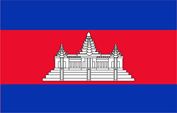 |
Nationalflagge – national flag, Seitenverhältnis – ratio = 16:25, auch/even 2:3, Quelle/Source, nach by: Flags of the World   |
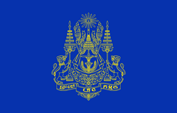 |
Flagge des Königs – flag of the king, Seitenverhältnis – ratio = 16:25, Quelle/Source: SodacanThis W3C-unspecified vector image was created with Inkscape. [CC BY-SA 3.0], via Wikimedia Commons |
historische Flaggen – historical Flags: |
|
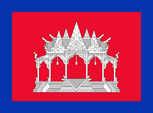 |
1893–1942, Nationalflagge – national flag, Quelle/Source, nach by: Flaggenbuch 1939 |
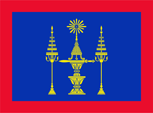 |
1893–1945(?), Flagge des Königs – flag of the king, Quelle/Source, nach by: Flaggenbuch 1939 |
 |
1942–1945 (Japan. Occupation), Nationalflagge – national flag, Seitenverhältnis – ratio = 2:3, Quelle/Source, nach by: Flags of the World |
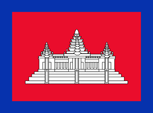 |
1945–1948, Nationalflagge – national flag, Quelle/Source, nach/by: World Statesmen |
 |
1948–1970, |
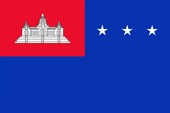 |
1970–1975, |
 |
1975–1976, |
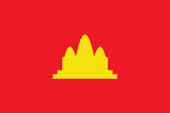 |
1975–1979, |
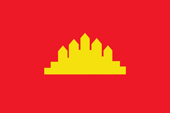 |
1979–1989, |
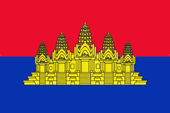 |
1989–1991, |
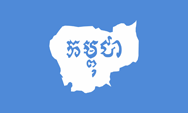 |
1991–1993, |
Bedeutung/Ursprung der Flagge – Meaning/Origin of the Flag: |
|
| Die Flagge von Kambodscha zeigt drei waagerechte Streifen in den Farben Blau, Rot und Blau, im Verhältnis 1:2:1, und trägt im mittleren roten Streifen eine Abbildung des Tempels von Angkor Wat. Die Farben Blau und Rot fanden schon sehr lange Verwendung in den Flaggen des Landes. Zur Bedeutung der Farben gibt es zwei verschiedene Erklärungen: | The flag
of Cambodia shows three horizontal stripes in the colours blue, red and
blue, in the ratio 1:2:1, and carrys in the middle red stripe a depiction of
the temple of Angkor Wat. The colours blue and red are already since long
times in use in the flags of the land. For explanation of the colours there exist two different theories. |
|
|
| Der weiße Tempel symbolisiert die glorreiche Vergangenheit des Landes. Weiß steht auch für das Vertrauen des Volkes auf seinen Herrscher. Die Flagge existierte in dieser Form bereits bis 1970 und wurde am 29.06.1993 durch einen Erlass von Prinz Sihanouk erneut angenommen. Unter den sozialistischen Regierungen wurden zwischen 1975 und 1989 rote, den Kommunismus symbolisierende Flaggen mit einer gelben Darstellung des Tempels von Ankor Wat verwendet. | The white
temple symbolizes the glorious past of the land. White stands also for the
confidence of the people in its sovereign. The flag exists in this design already until 1970 and was on 29th of june in 1993 adoped again per edict by prince Sihanouk. Under the socialistic governments between 1975 and 1989 there were in use red flags – symbolizing the communism – with an depiction of the temple of Ankor Wat in yellow. |
| Die Farben der Flagge von Kambodscha werden neben Schwarz und Weiß folgendermaßen angegeben: Blau = RGB 3|46|161, was Pantone 286 entsprechen würde, Rot = RGB 224|0|37, was Pantone 185 entsprechen würde, Gelb = RGB 252|221|9, was Pantone Yellow C entsprechen würde, Hellblau = RGB 91|146|229, was Pantone 279 entsprechen würde. Das kommunistische Rot wird angegeben mit RGB 218|18|26, was Pantone 1788 entsprechen würde. | The colors of the flag of Cambodia are specified as follows, besides black and white: Blue = RGB RGB 3|46|161, which would correspond to Pantone 186, Red = RGB 224|0|37, which would correspond to Pantone 185, Yellow = RGB 252|221|9, which would correspond to Pantone Yellow C, Pale Blue = RGB 91|146|229, which would correspond to Pantone 279. The communist red is specified as RGB 218|18|26, which would correspond to Pantone 1788. |
| Quelle/Source: Wikipedia (EN) | |
Wappen – Coat of Arms: |
|
 |
seit/since 1993, Wappen vom Kambodscha – coat of arms of Cambodia, Quelle/Source: Sodacan, Public domain, via Wikimedia Commons |
Bedeutung/Ursprung des Wappens – Meaning/Origin of the Coat of Arms: |
|
| Das Wappen von Kambodscha ist die Heraldik der kambodschanischen Monarchie. Es wurde in ähnlicher Form bereits 1953 angenommen. Es zeigt einen hellblauen Schild mit einem Unaome-Zeichen (Aum-Symbol), ein Schwert, zwei zeremonielle Podestplatten (Phan), einen Lorbeerkranz und den dem Königlichen Orden von Kambodscha, darüber die königliche Krone. Der Schild wird von den zwei königlichen Tieren gehalten, dem Gajasingha (Löwen mit Elefantenrüssel) auf der linken Seite und dem Rajasingha (königlicher Löwen) auf der rechten Seite. Jeder Löwe hält zwei königliche fünfstufige Regenschirme. Das blaue Spruchband zeigt in Khmer die Worte: "Herrscher des Königreichs Kambodscha". |
The coat of arms of
Cambodia is the heraldry of the Cambodian monarchy. It was adopted in a
similar form already in 1953. It shows a light blue shield with an Unaome sign (Aum symbol), a sword, two ceremonial pedestal plates (Phan), a laurel wreath and the Royal Order of Cambodia, above which is placed the royal crown. The shield is held by the two royal animals, the Gajasingha (elephant-trunked lion) on the left and the Rajasingha (royal lion) on the right. Each lion holds two royal five-tiered umbrellas. The blue banner shows in Khmer the words: "Ruler of the Kingdom of Cambodia". |
| Quelle/Source: Wikipedia (EN) | |
historische Wappen – historical Coats of Arms: |
|
 |
1970–1975, Wappen der Republik Khmer – coat of arms of Khmer Republic, Quelle/Source: Vektorisiert von FOX 52, CC BY-SA 4.0, via Wikimedia Commons |
 |
1975–1982, Wappen des Demokratischen Kampuchea – coat of arms of Democratic Kampuchea, Quelle/Source: vectorized by Elena in General, Public domain, via Wikimedia Commons |
 |
1979–1981, Wappen der Volksrepublik Kampuchea – coat of arms of People's Republic of Kampuchea, Quelle/Source: Ericmetro, Public domain, via Wikimedia Commons |
 |
1981–1989, Wappen der Volksrepublik Kampuchea – coat of arms of People's Republic of Kampuchea, Quelle/Source: Victor Bing, CC BY-SA 4.0, via Wikimedia Commons |
 |
1989–1992, Wappen des Staats Kambodscha – coat of arms of the State of Cambodia, Quelle/Source: Sarumo74, CC BY 3.0, via Wikimedia Commons |
Flugzeugkokarde – aircraft roundel: |
|
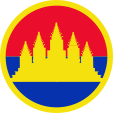 |
1989–1993, Flugzeugkokarde – aircraft roundel Quelle/Source, nach/by: Wikipedia (EN) |
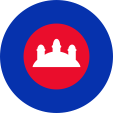 |
seit/since 1993, Flugzeugkokarde – aircraft roundel Quelle/Source, nach/by: Wikipedia (EN) |
Landkarte – Map: |
Lage – Position: |
Landkarte des Landes – Map of the Country: |
|
|
Zahlen und Fakten – Numbers and Facts: |
|
|
|
|
|
|
|
|
|
|
|
|
|
|
|
|
|
|
|
Geschichte: |
| 200–600 · Reich Funan 7. Jhd. · Eroberung durch die Khmer, Etablierung des Khmer-Reiches 802 · Gründung des Königreiches Kambuja 13. Jhd. · Einfälle der Thai, Schan und Mongolen 1353 · die Thai erobern die Hauptstadt Angkor, kurzzeitige Etablierung einer Thai-Dynastie 1431 · Verlegung der Hauptstadt von Angkor nach Phnom Penh 1623 · vietnamesische Invasion 1660 · der König der Khmer wird von den Thai gefangen genommen, Kambodscha gerät in siamesische Abhängigkeit 1863 · Frankreich schließt einen Schutzvertrag mit Kambodscha, um es vor der Annexion durch Siam (Thailand) zu bewahren 1867 · Siam erkennt das französische Protektorat über Kambodscha an 1884 · die französische Kolonialverwaltung übernimmt alle hoheitlichen Rechte des Landes 1887 · Bildung von Französisch-Indochina, eigentlich Union von Indochina/Union Indochinoise (Zusammenschluss der französischen Gebiete: Tongking, Annam, Cochinchina, Laos und Kambodscha 1893 · Laos wird an Französisch-Indochina angeschlossen 1941 · Japanische Truppen besetzen Französisch-Indochina, Kambodscha muss Gebiete im Norden und Westen an Thailand (Siam) abtreten August 1945 · Verkündung der Unabhängigkeit durch Prinz Sihanouk Oktober 1945 · Einmarsch französischer Kolonialtruppen 1946 · Wiedererrichtung des französischen Protektorats, Beginn des bewaffneten Widerstands gegen die Kolonialmacht (vor allem in Vietnam), bis 1954 Eskalation zum Indochinakrieg 1947 · Frankreich gewährt den Status einer konstitutionellen Monarchie 1949 · Frankreich gewährt Unabhängigkeit im Rahmen der Französischen Gemeinschaft 09.11.1953 · die französische Kolonialverwaltung wird aufgelöst, Tag der Unabhängigkeit 21.07.1954 · Waffenstillstandsverhandlungen auf der Genfer Indochina-Konferenz, der Erste Indochinakrieg endet, Frankreich zieht seine Truppen aus ganz Indochina ab, die Unabhängigkeit Kambodschas wird bestätigt 1955 · Prinz Sihanouk dankt als König ab, erlässt eine neue Verfassung und wird Ministerpräsident von Kambodscha, Politik strikter Neutralität 1960 · Prinz Sihanouk übernimmt das Amt des Staatschefs (Staatspräsident) 1969 · General Lon Nol wird Ministerpräsident 1970 · General Lon Nol putscht gegen Prinz Sihanouk und wird Staatschef, Umbenennung Kambodschas in République Khmer, pro-US-amerikanische Politik, Einmischung in den Vietnamkrieg 1970–1975 · Bürgerkrieg in Kambodscha, kommunistische Rebellen unter Pol Pot (Rote Khmer) und Anhänger von Prinz Sihanouk kämpfen mit Unterstützung von Nord-Vietnam gegen Truppen und Anhänger von General Lon Nol 1972 · General Lon Nol wird Staatspräsident 17.04.1975 · Niederlage der Truppen Lon Nols gegen die Roten Khmer und die Anhänger von Prinz Sihanouk, General Lon Nol geht in die USA ins Exil, Prinz Sihanouk wird Staatschef 1976 · Prinz Sihanouk wird von den kommunistischen Roten Khmer gestürzt und unter Hausarrest gestellt, die République Khmer wird in Demokratisches Kambodscha umbenannt, die Roten Khmer schließen die Grenzen des Landes und beginnen mit "Säuberungsaktionen" größeren Ausmaßes und Beginnen ein Umerziehungsprogramm für das gesamte Volk dem bis 1978 ein Viertel der Bevölkerung des Landes zum Opfer fällt 1977 · Grenzkonflikte mit Vietnam 1978 · Vietnam interveniert in Kambodscha und beendet am 07.01.1979 die Herrschaft der Roten Khmer, Machtübernahme durch den vietnamhörigen Heng Samrin, Prinz Sihanouk geht ins Exil 10.01.1979 · Proklamation der Volksrepublik Kambodscha 1979–1990 · Bürgerkrieg in Kambodscha, Rote Khmer, Royalisten und bürgerliche Gruppen bekämpfen die vietnamesischen Besatzungstruppen und Staatschef Heng Samrin 1982 · Prinz Sihanouk bildet eine Exilregierung unter Einbindung aller Widerstandsgruppen 1985 · Pol Pot tritt als Oberkommandierender der Roten Khmer zurück 1988 · Verhandlungen der Exilregierung mit der Regierung Heng Samrin 1989 · Abzug der vietnamesischen Truppen 1990 · Bildung des Obersten Nationalrates, als gemeinsame Regierung aller Konfliktparteien (Rote Khmer, Royalisten, Bürgerliche, Anhänger Heng Samrins) 1991 · Friedensvertrag von Paris 1993 · Parlamentswahlen (von den Roten Khmer boykottiert), Sieg der FUNCINPEC-Partei von Prinz Ranariddh (Sohn von Prinz Sihanouk), Niederlage der Volkspartei von Hun Sen, neue Verfassung, Kambodscha wird Königreich, Prinz Sihanouk wird König, Prinz Ranariddh wird Premierminister 1994 · die Roten Khmer nehmen den Kampf wieder auf 1997 · bewaffneter Widerstand gegen Prinz Ranariddh, Hun Sen übernimmt die Macht 15.04.1998 · Tod von Pol Pot 26.07.1998 · Parlamentswahlen, Sieg der Volkspartei von Hun Sen, die FUNCINPEC-Partei von Prinz Ranariddh koaliert mit der Volkspartei, Hun Sen wird Ministerpräsident, Prinz Ranariddh wird Parlamentspräsident, Wiedereingliederung der Roten Khmer in das öffentliche Leben und die Armee 1999 · der letzte Führer der Roten Khmer wird gefangen genommen 2004 · König Sihanouk dankt ab, König wird sein Sohn Norodom Sihamoni |
History: |
| 200–600 · Empire of
Funan 7th cent. · conquest by the Khmer, establishment of the Khmer Empire 802 · foundation of the Kingdom of Cambuia 13th cent. · invasions of the Thai, Shan and Mongolians 1353 · the Thai conquer the capital Angkor, momentary establishment of a Thai dynasty 1431 · transfer of the capital from Angkor to Phnom Penh 1623 · Vietnamese invasion 1660 · the King of the Khmer gets captured by the Thai, Cambodia comes in Siamese dependence 1863 · France makes a protection treaty with Cambodia, to protect it against an annexation by Siam (Thailand) 1867 · Siam recognizes the French protectorate over Cambodia 1884 · the French colonial administration takes over all sovereignty rights of the country 1887 · establishment of French Indochina, actually named Union of Indochina/Union Indochinoise (unification of all French territories: Tongking, Annam, Cochinchina, Laos and Cambodia 1893 · Laos gets annexed into French Indochina 1941 · Japanese troops occupy French Indochina, Cambodia has to cede areas in the north and west to Thailand (Siam) August 1945 · proclamation of independence by Prince Sihanouk October 1945 · invasion of French colonial troops 1946 · re-establishment of the French protectorate, beginning of the armed resistance against the colonial might (especially in Vietnam), until 1954 escalation to the Indochina War 1947 · France grants the status of a constitutional monarchy 1949 · France grants independence in framework of the French community 9th of November 1953 · the French colonial administration gets dissolved, day of independence 21st of July in 1954 · armistice negotiation at the Genf Indochina Conference, the First Indochina War ends, France withdraws its troops from whole Indochina, the independence of Cambodia is confirmed 1955 · Prince Sihanouk resigns as King, passes a new constitution and becomes premier of Cambodia, policy of strict neutrality 1960 · Prince Sihanouk takes over the function of Chief of State (State's President) 1969 · General Lon Nol becomes premier 1970 · General Lon Nol revolts against Prince Sihanouk and becomes Chief of State, rename of Cambodia in République Khmer, pro-US-American policy, intervention into the Vietnam War 1970–1975 · civil war in Cambodia, communist rebels under Pol Pot (Red Khmer) and followers of Prince Sihanouk struggle by support of North Vietnam against troops and followers of General Lon Nol 1972 · General Lon Nol becomes State's President 17th of April 1975 · defeat of Lon Nol's troops against the Red Khmer and the followers of Prince Sihanouk, General Lon Nol exiles in the USA, Prince Sihanouk becomes Chief of State 1976 · Prince Sihanouk gets unseated by the communist Red Khmer and comes under house arrest, rename of the République Khmer in Democratic Cambodia, the Red Khmer close the borders of the country and begin with "cleaning campaigns" of biger dimensions and begin a re-education program for the whole nation, until 1978 dies in this way a quarter of the population of the country 1977 · frontier conflicts with Vietnam 1978 · Vietnam intervenes in Cambodia and terminates on the 7th of January 1979 the reign of the Red Khmer, seize of power by the from Vietnam dependent Heng Samrin, Prince Sihanouk exiles 10th of January 1979 · proclamation of the People's Republic of Cambodia 1979–1990 · civil war in Cambodia, Red Khmer, royalists and bourgeois groups struggle against the Vietnamese occupation troops and the Chief of State Heng Samrin 1982 · Prince Sihanouk forms an exile government under inclusion of all resistance groups 1985 · Pol Pot resigns as commander of the Red Khmer 1988 · negotiations of the exile government with the government of Heng Samrin 1989 · withdrawal of the Vietnamese troops 1990 · establishment of the supreme national counsel, as a mutual government of all conflict camps (Red Khmer, royalists, bourgeois, followers of Heng Samrin) 1991 · Paris Peace Treaty 1993 · elections of a parliament (boycotted by the Red Khmer), victory of the FUNCINPEC-Party of Prince Ranariddh (son of Prince Sihanouk), defeat of the People's Party of Hun Sen, new constitution, Cambodia becomes kingdom, Prince Sihanouk becomes King, Prince Ranariddh becomes prime minister 1994 · the Red Khmer begin the struggle again 1997 · armed resistance against Prince Ranariddh, Hun Sen seizes the power 15th of April 1998 · death of Pol Pot 26th of July 1998 · parliament's elections, victory of Hun Sen's People's Party, the FUNCINPEC-Party of Prince Ranariddh coallies with the People's Party, Hun Sen becomes premier, Prince Ranariddh becomes President of the Parliament, re-integration of the Red Khmer into the public live and into the army 1999 · the last leader of the Red Khmer is captured 2004 · King Sihanouk abdicates, his son Norodom Sihamoni becomes king |
| Quelle/Source: Atlas zur Geschichte, World Statesmen, Wikipedia (D) |
Ursprung des Landesnamens – Origin of the Country's Name: |
|
| Der Name von Kambodscha geht auf das Reich Kambuja zurück, eine Staatsgründung des Khmer-Volkes, die hier vom 9. bis zum 15. Jahrhundert bestand. Das Reich geriet danach in Abhängigkeit seiner Nachbarn. Dennoch wurde der Name beibehalten, und zwar als "Kampuchea", im Westen als "Kambodscha" bekannt. Nur kurze Zeit, zwischen 1970 und 1975, hieß das Land "Republik Khmer". Heute scheint sich die Praxis durchgesetzt zu haben das Land als sozialistisches Land als "Kampuchea" zu bezeichnen und für den bürgerlich-monarchistischen Staat "Kambodscha", kurios, es ist ein und das selbe Wort. | The name of Cambodia goes back to the Kambuja Empire, a founding of the Khmer
nation, which existed here from the 9th to the 15th century. The empire then became dependent on its neighbors. Nevertheless, the name was retained, namely as "Kampuchea", known to the west as "Cambodia". Only briefly, between 1970 and 1975, the country was called "Republic of Khmer". Today the practice seems to have prevailed of calling the country "Kampuchea" as a socialist country and "Cambodia" for the bourgeois-monarchist state, curiously, it's one and the same word. |
| Quelle/Source: Wikipedia (D) | |
|
Mit freundlicher Untersützung von: Kindly supported by: |
Siegfried Ehrmann |